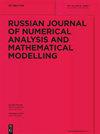Numerical evaluation of the effectiveness of coronary revascularization
IF 0.6
4区 数学
Q4 MATHEMATICS, APPLIED
Russian Journal of Numerical Analysis and Mathematical Modelling
Pub Date : 2021-11-01
DOI:10.1515/rnam-2021-0025
引用次数: 6
Abstract
Abstract In the present paper we construct the model of coronary flow which utilizes the patient’s CT data on both large CA and perfusion. We reconstruct large coronary vessels based on the CT data and extrude possibly invisible vessels from the branches of the left coronary artery so that every terminal point supply every of standardized zone of myocardium. We apply a previously developed and validated 1D model of haemodynamics. Utilizing the patient-specific CTP data for modifying outflow terminal resistance at rest and under stress conditions is the major novelty of the present work. From our results it follows that acceptable values of fractional flow reserve (FFR) after the stenotic treatment may produce false negative output. Therefore healthy FFR values may be observed after ineffective revascularization. We also conclude that microvascular perfusion impairment plays significant role in correct computational estimation of haemodynamic indices before stenotic treatment. The advantage of the presented approach is the availability of transmural perfusion ratio assessment in everyday practice.冠状动脉血运重建有效性的数值评估
摘要在本文中,我们构建了冠状动脉血流模型,该模型利用了患者在大CA和灌注方面的CT数据。我们根据CT数据重建大的冠状动脉血管,并从左冠状动脉的分支中挤出可能不可见的血管,使每个终点都能提供心肌的每个标准区。我们应用了先前开发和验证的血液动力学1D模型。利用患者特异性CTP数据来修改静息和应激条件下的流出端阻力是本工作的主要新颖之处。根据我们的结果,狭窄治疗后血流储备分数(FFR)的可接受值可能会产生假阴性输出。因此,在无效的血运重建后可以观察到健康的FFR值。我们还得出结论,微血管灌注损伤在狭窄治疗前血流动力学指标的正确计算估计中起着重要作用。所提出的方法的优点是在日常实践中可以进行跨壁灌注比率评估。
本文章由计算机程序翻译,如有差异,请以英文原文为准。
求助全文
约1分钟内获得全文
求助全文
来源期刊
CiteScore
1.40
自引率
16.70%
发文量
31
审稿时长
>12 weeks
期刊介绍:
The Russian Journal of Numerical Analysis and Mathematical Modelling, published bimonthly, provides English translations of selected new original Russian papers on the theoretical aspects of numerical analysis and the application of mathematical methods to simulation and modelling. The editorial board, consisting of the most prominent Russian scientists in numerical analysis and mathematical modelling, selects papers on the basis of their high scientific standard, innovative approach and topical interest.
Topics:
-numerical analysis-
numerical linear algebra-
finite element methods for PDEs-
iterative methods-
Monte-Carlo methods-
mathematical modelling and numerical simulation in geophysical hydrodynamics, immunology and medicine, fluid mechanics and electrodynamics, geosciences.

 求助内容:
求助内容: 应助结果提醒方式:
应助结果提醒方式:


